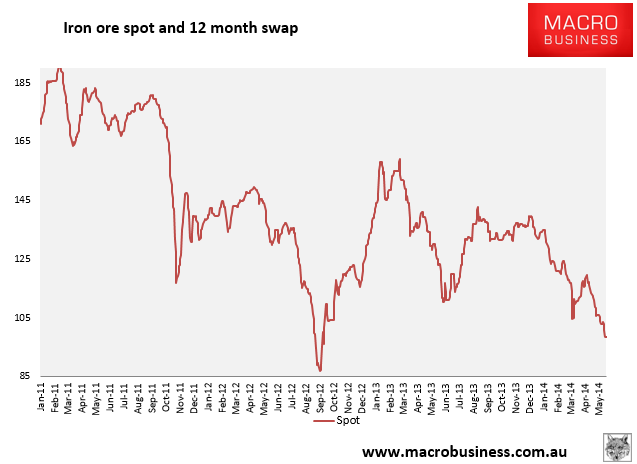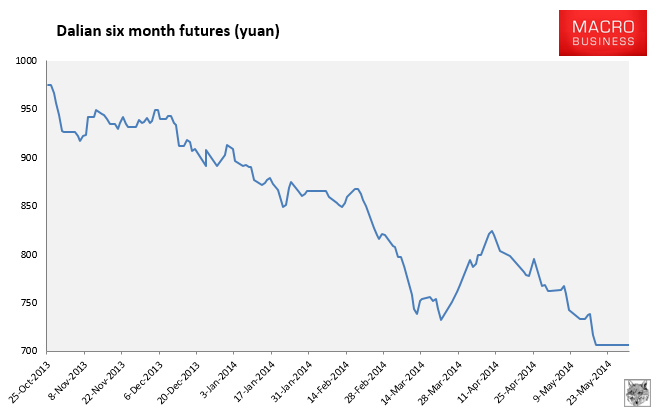The iron ore spot price fell another 2.2% yesterday to $98.50:

Dalian futures were down similarly at 707 yuan, a new record low:
Rebar futures were down and the Baltic Dry capesize component fell 2%.
In news, it’s not all gloom. Estimates are beginning to seep out of the impact of India’s latest iron ore self-immolation. From the WSJ:
“This is going to affect India’s iron ore production in a big way and therefore, production of steel,” said Basant Poddar, vice chairman of the Federation of Indian Mineral Industries, the country’s leading mining industry body.
He said the court order may mean that India’s exports this financial year could end up at around last year’s level of 15 million metric tons, clouding expectations of a rise in output to around 22 million tons because of a partial relaxation of mining bans and the election of a new industry-friendly government last week.
And from Creamer’s:
According to Tata Steel and Federation of Indian Mineral Industries, the court order would seriously impact supply of raw material for the steel industry, both in terms of availability and prices, with several steel plants in the province dependent on iron-ore from the region forced to resort to high-cost imports of iron-ore.
The fall in domestic supplies and forced import dependency would also reverse the current falling trend in iron-ore imports.
During 2013/14 Indian imports of iron-ore fell to a five-year low at 420 000 t, down 86% over the previous year when imports had touched 3.05-million tonnes.
…According to analysts, Tata Steel and SAIL, two of the country’s largest steel producers, would be most impacted by the mines closure. Tata Steel would have one lease still valid in the province, which would produce a maximum of 1.2-million tonnes a year, while SAIL would have two valid leases with maximum production capacity of 3-million tonnes a year.
Tata Steel, with domestic production capacity of about 10-million tonnes a year, sourced an estimated 75% of its ore requirement from captive mines in Odisha. While no information was available of the company’s existing inventory of the raw material, analysts said that the steel producer would have to source ore from open market auctions within the country and also resort to imports.
At a wild guess, if 40 million tonnes per annum are offline for six months then we’ve got a 20 million tonne swing in the market. With some steel capacity closures and take up from wider sources in domestic ore we might see half of that covered. Goan iron ore will likely still be exported but Odissan ore is as well so we might see a net 10 million tonne import boost from India. Helpful but probably not material if rough guesstimates of the current 40 million tonnes (double for full year) of oversupply are right.
That seems to be the conclusion of markets, anyway, which have brushed this off like a dust mote. Indeed, add in Ukraine and a potential Port Hedland strike and if we were in 2011 the iron ore price would going absolutely berserk above $200.
Times have changed.

